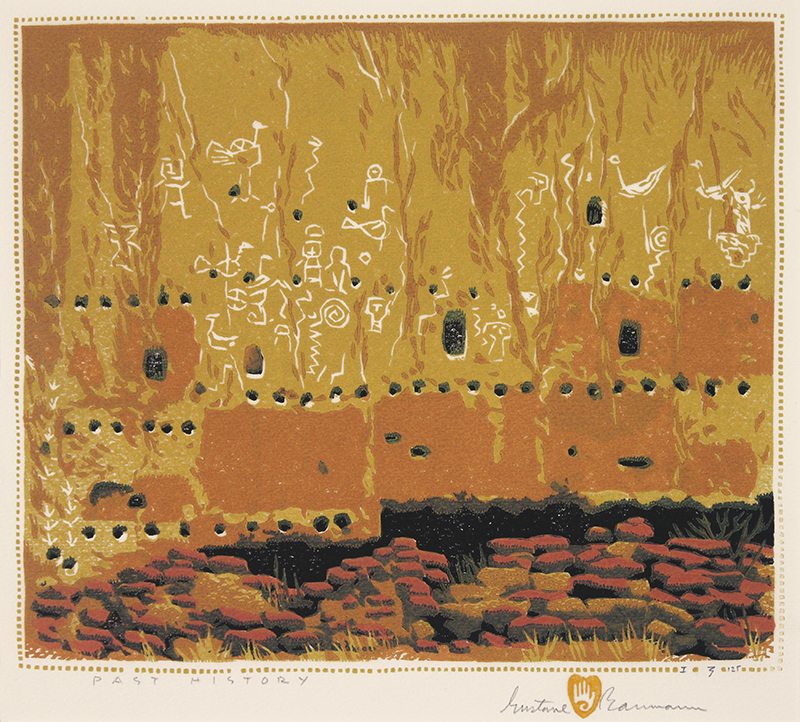Past History is a color woodcut from 1946 by American master printmaker Gustave Baumann (1881-1971). This impression is pencil signed, titled, and editioned I 3-125. It was printed by the artist on a white J.W. Zanders pebbled wove paper and the image measures 9-3/8 x 10-7/8 inches.
The reference for this work is Chamberlain 168. For an explanation of the printing record for this color woodcut and the number of blocks used, we refer you to pages 423-424 of In A Modern Rendering The Color Woodcuts of Gustave Baumann: A Catalogue Raisonné.
This impression of Past History is opaquely printed in rich, vibrant earth tones. The location is the south facing wall of Long House in Frijoles Canyon, now part of Bandelier National Monument. The petroglyphs have hardly eroded but are best seen in raking light. Baumann wrote about the petroglyphs of Frijoles Canyon: Mankind seems to have been blessed with the innate ability to draw when he allows his hand to follow the dictates of his mind….We don’t know just how much the ravages of time have obliterated but what remains is an intriguing puzzle to ponder over. Frijoles Canyon when I first saw it was such a place. Guided there by Kenneth Chapman of the School of American Research, I found it to the on the those practically intact and “out of this world places” which had induced Adolph Bandelier that roving archeologist to write a novel about it some year previous to its rediscovery. The novel he wrote is no limping effort; it has substantial value—what puzzles me is that no where [sic] does he mention the drawings in the caves which like all of us he must have clambered in and out of time and again.
Gustave Baumann was born in Magdeburg, Germany on 27 June 1881. Ten years later his family immigrated to the US, settling in Chicago. In 1896, Baumann began working in the commercial art field while saving money to study in Germany. After returning from Munich in December 1905 where he studied at the Kunstgewerbeschule, Baumann worked again in commercial art to support his family. In 1909, he discovered Brown County, Indiana where life was inexpensive and he could stay for three months. He produced a series of small format color woodcuts featuring the people and places of Brown County and then produced five large format color woodcuts. His woodcuts were accepted by the committee for the 1915 Panama Pacific International Exposition and he won a gold medal in 1916. Baumann headed east to Wyoming, New York in 1917 and taught at a summer school. From there he headed to Provincetown and New York City before returning to set up his studio in Wyoming. The southwest beckoned and he headed west in May 1918, stopping in Taos for the summer and fall. His funds were low and he needed to head back to Chicago but first stopped at the new art museum in Santa Fe to see an exhibition of his woodcuts. The rest, they say, is history.



